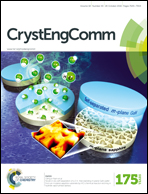A highly stable dimethyl-functionalized Ce(iv)-based UiO-66 metal–organic framework material for gas sorption and redox catalysis†
Abstract
The new, dimethyl-functionalized Ce(IV)-based UiO-66 (UiO = University of Oslo) metal–organic framework (MOF) material Ce-UiO-66-(CH3)2 (1) was successfully synthesized under solvothermal conditions (100 °C, 15 min) by employing ammonium cerium(IV) nitrate and the 2,5-dimethyl-1,4-benzenedicarboxylate (H2BDC-(CH3)2) ligand in a DMF/H2O (DMF = N,N-dimethyl formamide) mixture. The phase purity of the as-synthesized and thermally activated form (1′) of the compound was confirmed by a combination of X-ray powder diffraction (XRPD) analysis, Fourier transform infrared (FT-IR) spectroscopy and thermogravimetric (TG) analysis. As verified by the thermogravimetric analysis, the compound is thermally stable up to 300 °C in air atmosphere. Based on the XRPD measurements, the material retains its crystallinity after treatment with water, methanol, acetic acid and 1 M HCl. As confirmed by the gas sorption experiments, the compound shows significant microporosity towards N2 (BET surface area = 845 m2 g−1) and CO2 (adsorption capacity = 34 cm3 g−1 at 0 °C and 1 bar). The catalytic activity of 1′ has been studied in the oxidation of styrene and cyclohexene using tert-butylhydroperoxide (TBHP) as the terminal oxidant. The catalyst is reusable for four cycles with no significant drop in its activity which is further confirmed by a hot filtration experiment.



 Please wait while we load your content...
Please wait while we load your content...